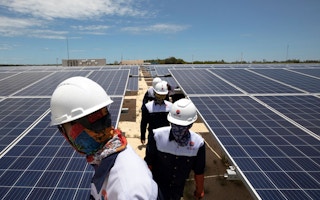Southeast Asia could unlock up to US$200 billion worth of revenue in manufacturing renewable energy technology by the first half of the century, according to a report by research and consulting firm Mckinsey released on Thursday (30 March).
The regional bloc’s renewable opportunity could create six million jobs, mostly in building solar photovoltaic (PV) panels, two-wheeler electric vehicles (EVs) and batteries, said Vaibhav Dua, partner and leader of McKinsey’s sustainability practice in Southeast Asia.
“Manufacturing represents a core part of our gross domestic product. It’s a backbone that we’ve had for a long time,” Dua said in a presentation to 1,000-strong in-person and virtual attendees at the Asian Development Bank’s Southeast Asia Development Symposium in Bali, Indonesia. “There is a lot of room for us to grow and not only meet the needs of the region, but also of the world.”
Southeast Asia has a 16 terrawatt (TW) potential for manufacturing solar photovoltaic technology, as Thailand, Vietnam and Malaysia already contribute up to 10 per cent of the world’s production of solar photovoltaic cells and modules, according to the report.
The region contributes six to 10 per cent of the world’s electric two-wheeler production primarly from Vietnam and Indonesia. As both nations are set to phase out fossil fuel-powered vehicles and replace them with EVs by 2040, sales are seen to increase from between 20 to 30 per cent at 4.3 million units in this timeframe.
Battery demand is currently limited at two gigawatts-hours (GWh), but is eyed to reach 80GWh by 2030 and 175GWh five years after. Indonesia and the Philippines collectively produce 25 per cent of the world’s nickel output for batteries that power the technologies for solar panels and low-carbon vehicles.

More than half of Southeast Asia’s US$160-200 billion revenue opportunity arises from low carbon mobility and clean power. Image: McKinsey
Foreign and local players have in recent years announced plans to set up operations in Southeast Asia, such as China-based companies JA Solar, Longi and Yadea as well as South Korean firms Hyundai, LG and Durapower.
The report stated: “Cooperation between an array of international and regional stakeholders is required to ensure that Southeast Asia secures its place as a global “centre of gravity” for renewable energy manufacturing, and to grow the overall aspiration for the region as a whole.”
Greening global value chains for survival
Like the manufacturing of EVs and solar panels, global value chains (GVCs) need to “promote and transition to clean energy” for their production and trade to avoid the risk of decline, according to a study released by ADB at the same conference.
GVCs refer to trade that is carried out in different countries that bring a product or service, like a smartphone or a car, from conception to market. More than two-thirds of world trade today takes place within value chains that cross at least one border during production.
The study noted how the recent surge in energy and commodity prices and the planned 2026 implementation of the Carbon Border Adjustment Mechanism – a carbon tariff placed on carbon intensive products such as cement and some electricity imported by the European Union – has made the decarbonisation of global value chains more urgent.
“Policies that promote decarbonisation … involve a careful balancing act between maximising the potential benefits of Asean GVCs and regional value chains while minimising the risks and costs of decarbonisation including the social costs from job displacement – as some producers and businesses close their shops – as economies go green,” ADB said.










